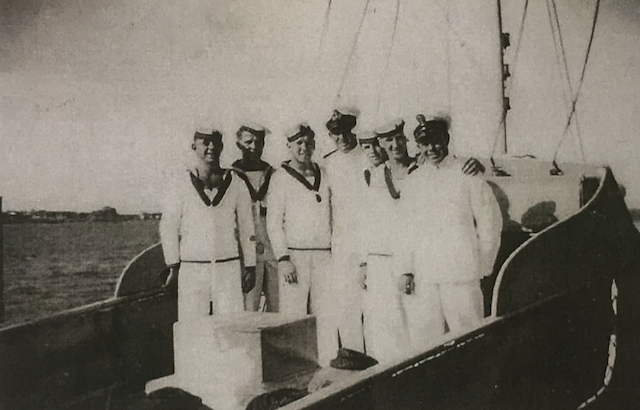
HMAS Lolita continued her patrol work following the Battle.
Anderson left Lolita and his crew on 1 October 1942. He was posted to HMAS Baralaba, a merchant steamship requisitioned to carry freight between North Queensland and New Guinea. When she was subsequently ‘paid off’, Anderson was posted to the survey vessel John Oxley, and later to command HMAS Kangaroo and Kookaburra at the Boom Depot in Darwin.
Lolita was posted to the port of Newcastle and remained there until her recall in 1944 for refit. Ken Brown recounted he worked well with the new commander and how Andrew respected his crew and gave them ‘every’ assistance and guidance.
Brown finished his stint with Lolita and Reg Andrew on 17 February 1943, and was posted to HMAS Platypus at Cairns.
The Board found the fire was accidently caused and that no blame was attributable to any officer or man. They also found that fire drills were regularly conducted on Lolita, in accordance with the Port Orders, and had been conducted the previous day. They also found the two seamen on board at the time made every endeavor to cope with the fire and acted in a prompt and efficient manner.
* * *
Further applications to enlist in mid 1942 were fruitless.
Through the VCP, he was offered a position to command one of the small tugs of the US Small Ships Section. The task was to tow lighters with stores and to operate very near the front lines in New Guinea and Solomon Islands areas. The pay offered was about four times what he was receiving at Spectacle Island. But once again the manpower authorities refused permission for him to accept the offer and ‘that was that’ as he said.
Finally, in December 1942, the defence officials relented and he was advised he would be allowed to enlist. He ‘rushed around’ putting his affairs in order, arranged leave from the VCP and sold Spray, his 30 foot gaff yawl sailing boat. By March 1943, clearance to enlist looked no closer and he purchased a small 24 foot sailing vessel so he could continue his work with the VCP.
He finally reported for duty on 10 September 1943, and was duly appointed as a Seaman on HMAS Marynong. He spent nearly a year on her patrolling at Newcastle and Wollongong, before being appointed to HMAS Miramar for a week, and onto Lolita on 23 August 1944.
136 NAA: MP138/1, 603/246/6400: Lolita - Sinking due to explosion in engine room 13/6/45., p.24. Commonwealth Government Gazette No. 177 of 25 June 1942
137 Interview of Ken Brown by author - 27 November 2018
138 Carruthers Collection, RAN Sea Power Centre - Australia. Carruthers initially understood the photo was the crew of Seamist, however Reg Andrew, commander of Seamist confirmed the photo was the crew of Lolita. The photo is also included in Ken Brown’s personal memoir.
139 The stoves used kerosene which when ignited burnt with a blue flame, hence the name.
140 NAA: A3978, 2009/00992645: Service record of Andrew R T. Carruthers makes no mention of Andrew’s appointment to HMAS Lolita.
141 In this and the following sections, details of my father’s work and service including aboard Lolita have been drawn from his unpublished personal memoir. Spectacle Island is located in the upper reaches of Sydney Harbour between Drummoyne and Woolwich.